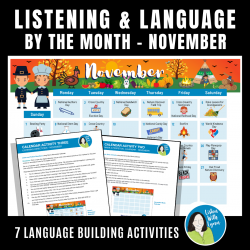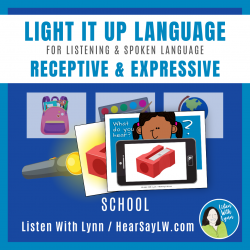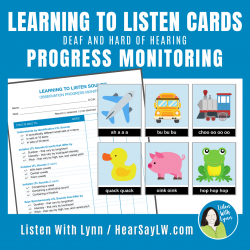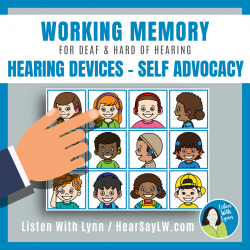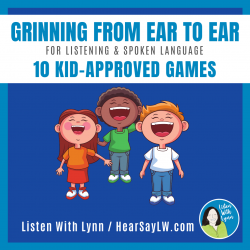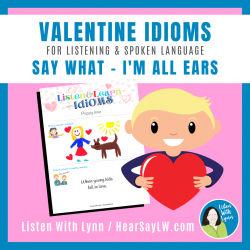Ability Levels
Categories
Resource Types
Age/Grade Range
CCSS
Anchor Standard
Speaking & Listening
Language
Reading
NOVEMBER LISTENING VOCABULARY COMPREHENSION
$ 5
The NOVEMBER Listening and Language By The Month resource includes seven activities that can be used ALL MONTH for auditory memory and comprehension, seasonal vocabulary, developing grammar, and build
...
SCHOOL Auditory Processing Receptive Expressive Vocabulary Riddles
$ 5
You'll love the SCHOOL version of Light It Up Language! Kids listen to clues presented through hearing alone to identify 16 hidden SCHOOL vocabulary pictures. Each of the pictures has four clues that
...
are increasingly more specific.
The magic happens by lighting up the “What Do You Hear?” cards. Hidden pictures are held up to a flashlight and the SCHOOL images amazingly appear. How fun! Once the hidden picture is revealed the child recalls and uses the clues to describe the SCHOOL SUPPLIES. Thereby stretching their auditory memory, descriptive language, and expressive language skills. TARGETS: RECEPTIVE: This game builds critical thinking and reasoning skills by categorizing, making inferences, and drawing conclusions. EXPRESSIVE: The child recalls and uses clues to describe the hidden object. Thereby, stretching their auditory memory, descriptive language, and expressive language skills. INCLUDES:
✧ Listening & language guide with instructions
✧ Target or goal suggestions
✧ 8 What Do You Hear? cards (printed twice)
✧ 16 Hidden SCHOOL Picture Vocabulary Cards
✧ 64 Prompt Clues - 16 objects with four details each that get increasingly more specific
✧ A Script with scaffolding strategies
✧ Listening and Spoken Language Tips
➼ EASY one-time quick game prep and you're all set to use year after year.
➼ You’ll need a FLASHLIGHT, a lamp, or a sunny window.
◈ ◈ ◈ ◈ ◈ ◈ ◈ ◈ ◈ ◈ ◈ ◈ ◈ ◈ ◈ ◈ ◈ ◈ ◈ ◈ ◈ ◈ ◈ ◈ ◈ ◈ ◈ ◈ ◈ ◈ CUSTOMER TIPS: ➼ Questions? Please email me before purchasing this resource or anytime later. STAY CONNECTED: ✧ Sign-up here for the Listen With Lynn emails
✧ Follow on Facebook - Lynn A. Wood - LSL Auditory Verbal Therapist and Rehab Audiologist
✧ Follow on Instagram @auditoryverbal_listenwithlynn
❤ Keep up your excellent work. I am blessed to help along the way. Thanks so much!
Lynn Wood
Learning To Listen Cards and Progress Monitoring Tool
$ 5
This resource includes a printable set of 30 Learning to Listen* Cards, an Observation Progress Monitoring Tool, and Tips For parents and professionals teaching the Learning To Listen Sounds and Phras
...
rases to a young child who is deaf or hard of hearing utilizing hearing technology such as cochlear implants or hearing aids with the goal of learning to listen and talk. INCLUDES:High-resolution Learning To Listen cards for quality printingObservation Progress Monitoring Tool10 Tips For teaching the Learning To Listen Sounds and PhrasesListening to Listen Sounds - Actions and AdjectivesLearning to Listen Sound - Object AssociationsLearning to Listen Sounds are associated with toys and objects that are commonly part of a baby or young child’s daily routines and activities. Individual families may use a variety of different Learning to Listen sounds, words and phrases depending on their lifestyle and culture. These onomatopoeic sounds contain acoustic properties that are significant in the perception of speech. The Learning to Listen Sounds are easy to hear for most babies wearing hearing technology.Skilled interventionists coach parents and caregivers about auditory skill development while presenting the Learning to Listen toys or activities. Observation data can be collected about the child’s auditory access to aspects of speech like duration, intensity, pitch, and voicing as well as vowel and consonant perception by contrasting toys in strategically chosen groups. This information is critical for optimally setting hearing aids and programming cochlear implants.*Adapted from Simser, 2002, Estabrooks, 2006, Estabrooks & Birkenshaw-Fleming, 1994.
Hearing Devices - Self Advocacy Working Memory
$ 2
If you have students who are deaf and hard of hearing that need help with auditory working memory, executive functioning, and following directions, this Listening Finger Walk is a must-have! It builds
...
lds vocabulary about types of hearing loss and hearing devices. It boosts confidence and helps children feel good about their own hearing technology. It's fun for the kids and a simple no-prep resource for you. Just open the PDF on your screen or print it and go!The colorful playing board features 16 children wearing hearing devices like hearing aids, cochlear implants, and bone-anchored hearing systems. You can target vocabulary like unilateral, bilateral, behind-the-ear, in-the-ear, earmolds, processor, headpiece, magnet, coil, microphone, and more.This Listening Finger Walk:➼ helps build listening skills and working memory by allowing kids to work with auditory information without losing track of what they're doing.➼ targets vocabulary, descriptive skills, spoken language, and communication skills.➼ has three rounds that each increase in auditory complexity.Includes:✧ A Hearing technology or devices theme for therapy sessions or school lessons✧ Listening and Spoken Language Tips✧ Print Version: Easy print and go!✧ Digital Version No Prep Ready to screen sharePlease Note: This activity and the Positive Self-Concept Auditory Learning Games contain similar images of the same children. The resources both target self-advocacy but have different auditory and language-based goals. You will want both resources you will want in your Summer Toolbox.◈ ◈ ◈ ◈ ◈ ◈ ◈ ◈ ◈ ◈ ◈ ◈ ◈ ◈ ◈ ◈ ◈ ◈ ◈ ◈ ◈ ◈ ◈ ◈ ◈ ◈ ◈ ◈ ◈ ◈ CUSTOMER TIPS:➼ Questions? EMAIL ME before purchasing this resource or anytime later♥ ♥ ♥ Sign-up HERE for the Listen With Lynn Emails♥ Let’s Connect:InstagramFacebookKeep up your excellent work. I am blessed to help along the way.Thanks so much!Lynn Wood
10 Kid Approved Games Grinning From Ear To Ear
$ 6
TEN Kid-approved listening games and language activities for your grab-and-go toolbox. Each game includes specific goals to target such as following directions, auditory memory, processing, and compre
...
rehension while building language and communication. I have used these games with children for countless years. Expect lots of giggles and grins.Ideal for: Teletherapy, Speech, Listening and Spoken Language, Distance Learning, Classroom, No PrintWhat's included:A 21-page resource with:✧ 10 Ready to Go Games - No-Prep or very little preparation✧ Detailed Gameplay suggestions✧ Answers to each prompt when appropriate✧ A helpful guide and instructions✧ Listening and Spoken Language (LSL) Tips✧ Terms of Use10 GAMES AND GOAL AREAS1. Woot Woot! Booooo! targets listening, auditory processing and comprehension of connected speech at the sentence level.2. I’m Going On A ________ targets listening, auditory memory and recalling details in sequence.3. Bean Bag Boogie targets listening, multi-step directions, auditory processing and comprehension.4. Simon Says Or Not targets listening, auditory processing, following multi-step directions and instructions.5. Thumbs Up. Thumbs Down targets listening, auditory processing and comprehension of connected speech at the sentence level.6. I Say - Go targets listening, temporal auditory memory skills, auditory processing and following multi-step directions.7. Found Sounds Outdoor Scavenger Hunt targets listening, identifying and localizing common outdoor sounds and their descriptors.8. Ear To Ear - Back To Back targets listening, auditory processing, following and giving directions, joint attention, two-way communication skills and cooperation.9. Do What You Hear Not What You See targets listening, following complex directions and auditory processing with distractions.10. Draw A Rhyme targets listening, following directions, auditory closure, phonemic awareness, recognizing and generating rhyming words.
VALENTINE Listen and Learn Idioms
$ 4
Valentine's Day Listen and Learn Idioms is part of the growing figurative language SAY WHAT? - I'M ALL EARS! series.YOU CAN TARGET:Listening and spoken language, figurative language, vocabulary,
...
word relationships, nuances, and higher-level critical thinking.WHAT'S INCLUDED:PDFs of 20 idioms in every packet. Use one or all!Listen and Draw MINI-LESSON sheets with A box to draw and illustrate - THIS IS WHAT I HEARD A box for - SAY WHAT? THIS IS WHAT IT REALLY MEANS!A guide and instructions to make lessons a piece of cakeData and Progress monitoring sheetsAn answer keyA boatload of book titles are included for further home learning➯ The PDFs can be printed in color or in black and white, screen shared in teletherapy or remote learning platforms, used in face-to-face sessions or lessons, and can be sent home for carryover or homework.➼ ➼HERE’S A TRICK TO MAKE IDIOMS STICK BLOG POST. SAY WHAT? Here's the trick to make idioms stick! Many commercially available resources provide ILLUSTRATIONS of the literal meaning of the idiom. While this may be entertaining RESEARCH indicates that children who:➼ LISTEN to the idiom➼ VISUALIZE the figurative language➼ DRAW what they literally heard followed by teaching the meaning andusing it in context increases long-term learning.Hearing LossChildren with typical hearing, learn idioms through incidental exposure without having to be taught. Whereas, children who are deaf and hard of hearing often require explicit and direct instruction with higher-level language like idioms. Idioms are challenging for children who process information literally and have a concrete or limited vocabulary.For more Figurative language activitiesSeries of IDIOMS Say What? I'm All Ears! LessonsFREE Monthly Riddles and Jokes Series◈ ◈ ◈ ◈ ◈ ◈ ◈ ◈ ◈ ◈ ◈ ◈ ◈ ◈ ◈ ◈ ◈ ◈ ◈ ◈ ◈ ◈ ◈ ◈ ◈ ◈ ◈ ◈ ◈ ◈ CUSTOMER TIPS:➼ Questions? Email me before purchasing this resource or anytime later.♥ Sign-up HERE for the Listen With Lynn Email♥ Let’s Connect:InstagramFacebookKeep up your good work. I am blessed to help along the way. Thanks so much!Lynn
 Your browser is out of date. For best experience switch to latest updated Browser.
Your browser is out of date. For best experience switch to latest updated Browser.
 Get Chrome
Get Chrome Get Edge
Get Edge Get Firefox
Get Firefox